 Jackpot, 2016
Jackpot, 2016
Introduction
A photograph is not a truth, it is a way of telling, sharing, evoking. The image we see is not perceived simply as itself, a bald visual fact. What our eye passes through to our brain is blended and assayed against what we remember and feel. The sense we make of the image is the result of a complex, mostly unconscious, conversation between the image, memory, established attitudes, current emotion and past experience. It is not so different for the photographer. The image they excise from the flow of space and time, freezing and framing the expansive evanescent moment into a flattened fixity, was itself ‘selected’ by critical faculties that are as much subconscious as intentional, however much we may feel ourselves to be in control. And, in this, we touch on the curious ambiguity of experience: that it is always being made and remade in the ongoing conversation between mind and materiality.
For the photographic artist, Roger Ballen, this ambiguity is not to be shied from but embraced. In it he intuits the fertile seeds of the human condition in all their multifarious and equivocal contrariety. His images inhabit a hermetically enfolded world with no door or window through which to escape to the familiar elsewhere. It is a theatre of the mind in which the roles of actor, props and scenery are not settled. At times, an object becomes the protagonist while the human figure is simply a context. The stories that the quick and the inanimate tell suggests allegory in which the key to simple interpretation is withheld. Instead, the tumblers of the mind roll over and over, trying to decipher the enigma that is its own message.
These images are unsettling in the very fact that they will not easily resolve to a neat denouement. The spectres of poverty and violence, while performing their roles with aesthetic absurdity, haunt these images with their tacit implication of complicity. Who is responsible for the dispossessed? Discomfort is a luxury of the comfortable. And why are these apparently alien images somehow so familiar? Is this hermetic world not so much the far-off land of a distant other’s imagination, but that which stretches deep within us, beyond the seas of consciousness?
Roger Ballen’s photographs have beguiled and challenged viewers for over five decades. His evolving path and his visual signature have stayed their idiosyncratic course, resisting the tainting lure of the art market or the greying blandishments of the status quo. His work maintains its uncompromising friction. These images do not slip smoothly into the mind, there to comfort and to confirm. They have their own purpose and dynamic. They have traction. They gesture out beyond the sea of consciousness to an enigma that is within us: familiar yet estranged.
Alasdair Foster
 Puppy Between Feet, 1999
Puppy Between Feet, 1999
Interview
Alasdair: When did you begin making photographs?
Roger: I bought my first camera, a Mamiya, in 1963 when I was thirteen. By that stage, my mother had been working for Magnum for some years. Through her conversation, and particularly her collecting, I was exposed to the work of many photographers – some of them now considered historically important. In this milieu, there was a complete belief in the value of photography in its ability to capture and convey meaning in a socio-documentary context.
One of the most vivid and pivotal moments in my life occurred in 1968 when my parents gave me a Nikon FTN camera for my high school graduation. The very first day I received it I went to the perimeter of Sing Sing prison near New York City to take photographs. Even now I can remember what that camera smelt like.
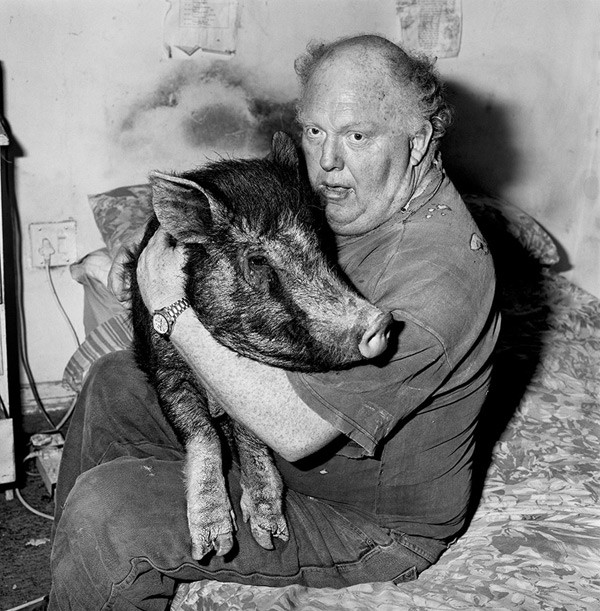 Brian with Pet Pig, 1998
Brian with Pet Pig, 1998
Your early series were broadly documentary in approach, albeit with an increasingly distinctive signature. When and why did you move towards making the constructed, existential psychodramas for which you are now most famous?
During the first two years of working on ‘Outland’ (1995 to 1996), my images were similar, both formally and aesthetically, to those I had taken for ‘Platteland’: individuals – photographed mainly from the front, statically – around the environments in which they lived. In 1997, however, my approach started slowly but surely to evolve. My photographs ceased being portraits in the traditional sense of the word, becoming instead images in which my subjects, both animals and humans, were actors; part of a silent theatre staged in a minimalistic world. It was my goal to eliminate as many visual references to South Africa as possible, and to create a reality that would reveal the universal circumstances of life.
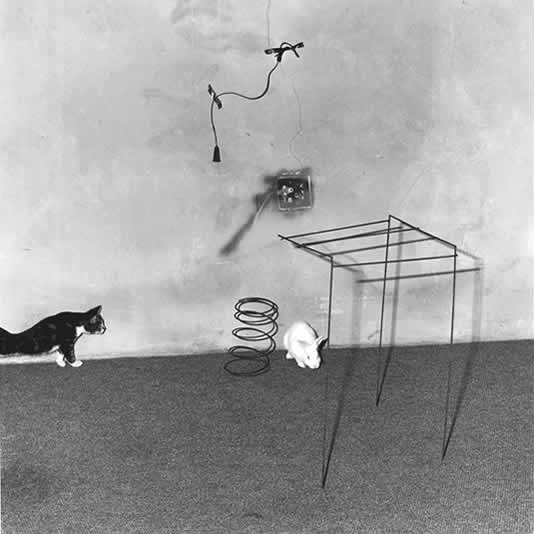 Animal Abstraction, 2002
Animal Abstraction, 2002
You have described yourself as a “visual organiser”. Can you explain what you mean by that?
There are an infinite number of ways to photograph the so-called external world. As an artist, my task is to link various objects, people, animals, drawings and so on in such a way that, together within the confines of a photograph, they belong to an organic whole. A whole that reveals an underlying message. Without the photograph, it is unlikely that these things would be linked in such a way or suggest such a meaning.
Even so, your images seem also to point to a kind of chaos: formally, in their relationships between unlikely elements, in the lives they suggest. How do you negotiate chaos and order in your images?
My photographs are never planned. Rather, it is my goal to arrive at a location with a quiet silent mind. Then the photographs come about through the interaction between my conscious and unconscious mind. Confusion and chaos are critical metaphors for the human condition. We try to find purpose in confusion, but fundamentally it is just confusion and chaos. It is clear to me that chaos dominates the human condition.
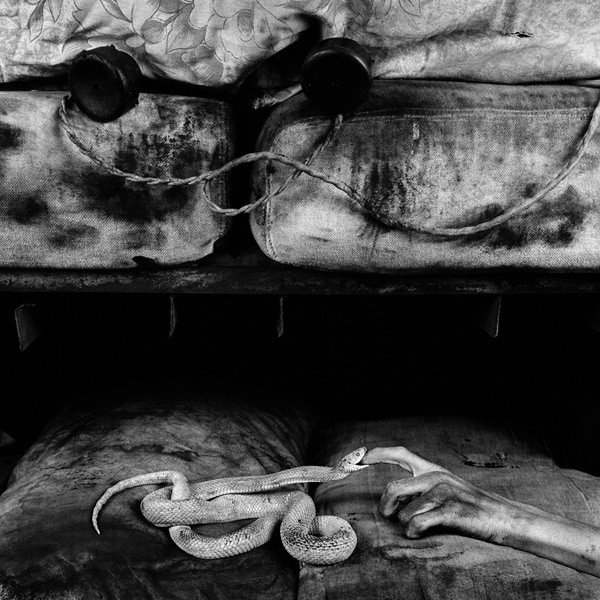 Bite, 2007
Bite, 2007
In bodies of work such as ‘Outland’, ‘Shadow Chamber’ or ‘Boarding House’, the people, animals and locations are all real. Can you describe how you go about making an image in these circumstances.
As in a painting where there are literally thousands of brushstrokes involved to produce the artwork, so it is with my process. It is important to recognise that most of my subjects for the past decade have been animals and, ultimately, it is my ability as a ‘visual organiser’ that is responsible for producing a work that is coherent and meaningful. It’s then my responsibility, and no one else’s, to recognise the exact moment when the picture should be taken. It is my job to perceive the flux as it moves from one point to another.
You have spoken about the impact of moving to a square format. What is it about the square frame that attracts you?
I have always believed that a photograph is like an organic being with every part integrated into a larger whole. The square is a perfect form, in which every side is of equal importance, equally balanced.
What is it that attracts you to the marginal and the precarious as subjects for your creative work?
It is impossible to state why. It is like asking why I like one colour over another. That said, it is clear to me that I identify with these subjects in some deep way. Nevertheless, my photographs continue to evolve and, since 2002, there is rarely a human face in my images, which shows that this aspect of humanity is not essential to my creative process.
For example, the images featured in ‘Asylum of the Birds’ were photographed within the confines of a house in a Johannesburg suburb. Looking back, the starting point for the project was the image of a disorientated dove against a wall: ‘Five Hands’. From this time on, birds were no longer confined to the heavens, but to a space dominated by chaos, ambiguity, violence, and death.
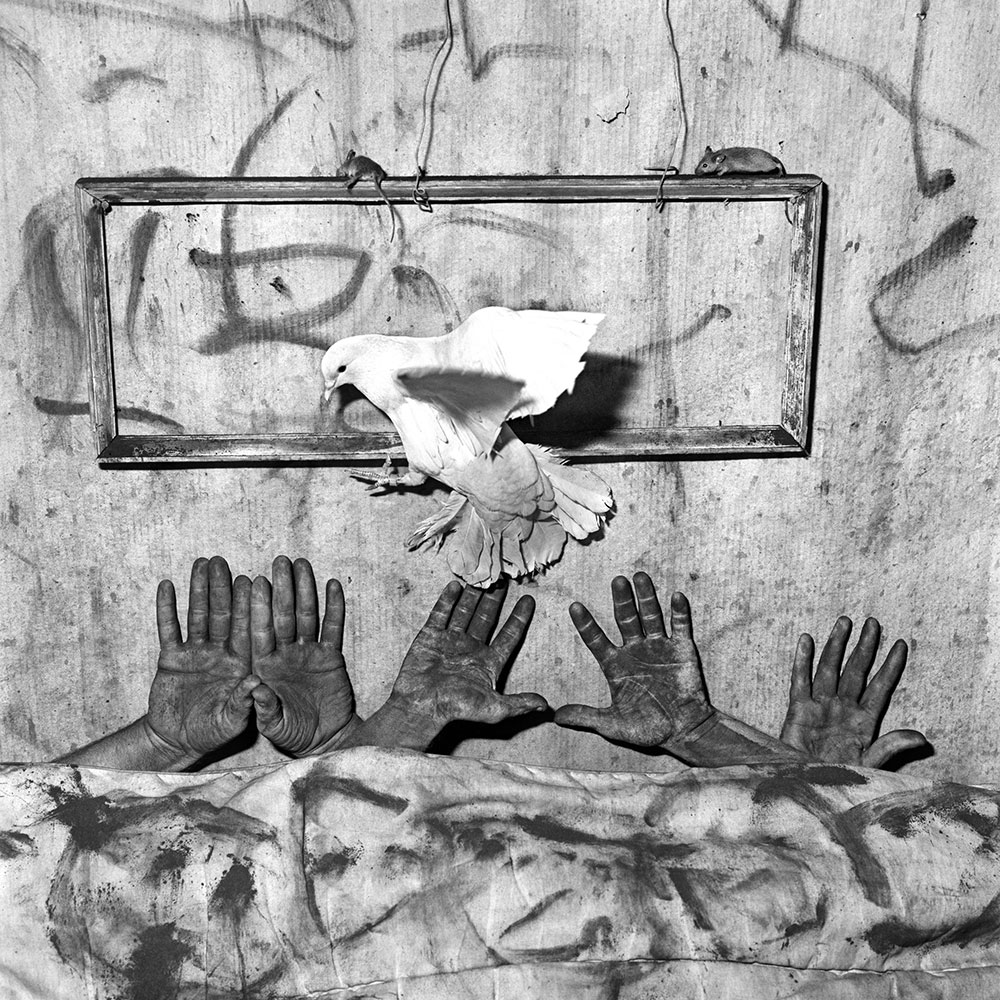 Five Hands, 2006
Five Hands, 2006
For me, your work is imbued with mood of darkness.
In the natural world there is no such thing as ‘light’ or ‘dark’. I do not see my images as dark or light, they are what they are. I think my photographs tend to imbed themselves in people’s repressed subconscious, creating a sense of existential anxiety. My images are powerful and provocative, they illicit within the psyche certain things that people would rather not confront. As a result, the images are referred to as ‘dark’ simply because they reveal something about the things buried in the subconscious mind.
I also find your work curiously enigmatic.
Ambiguity and enigma are fundamental to my imagery as they reflect the experience of life on the planet. When you ponder the nature of death, you begin to understand what enigma is. My goal is to create pictures that have this same uncertain quality. If you produce photographs that remain ambiguous, then perhaps you are making a profound statement.
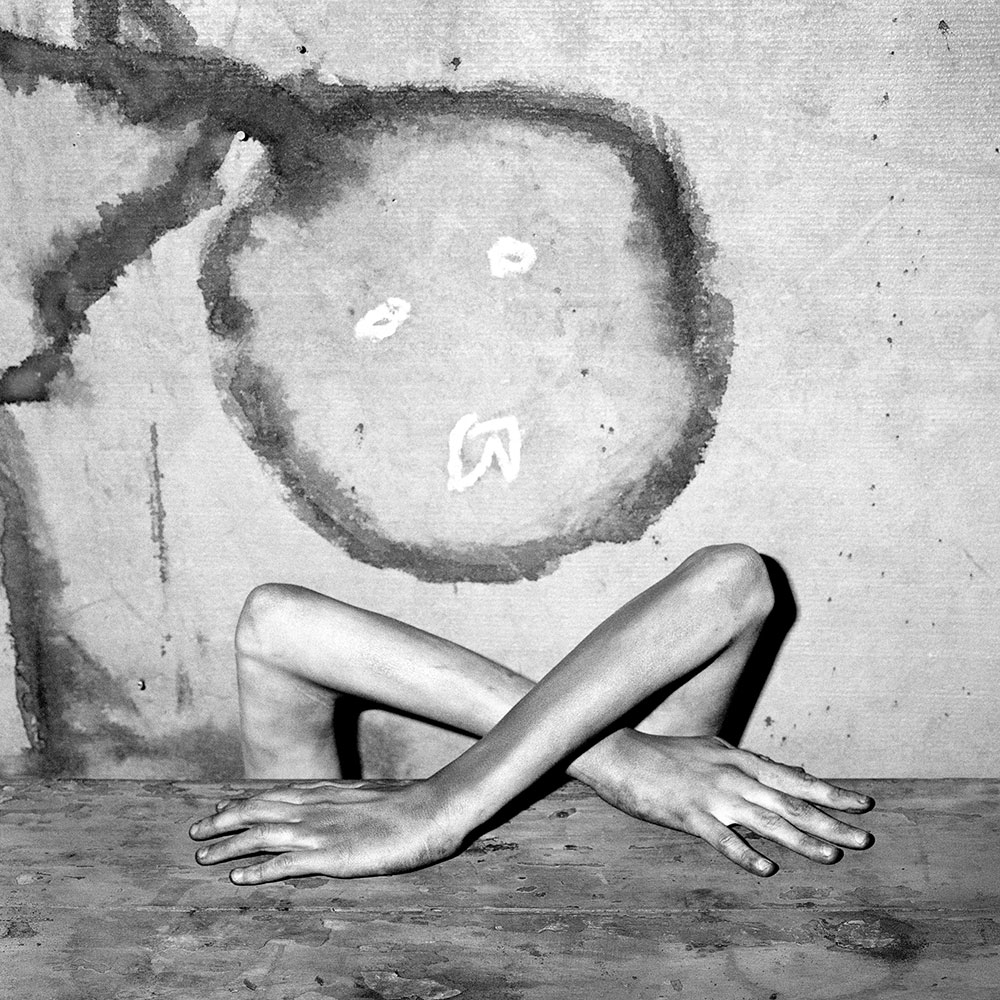 Mimicry, 2005
Mimicry, 2005
Can you give an example?
A central challenge in my career has been to locate the animal in the human being and the human being in the animal.
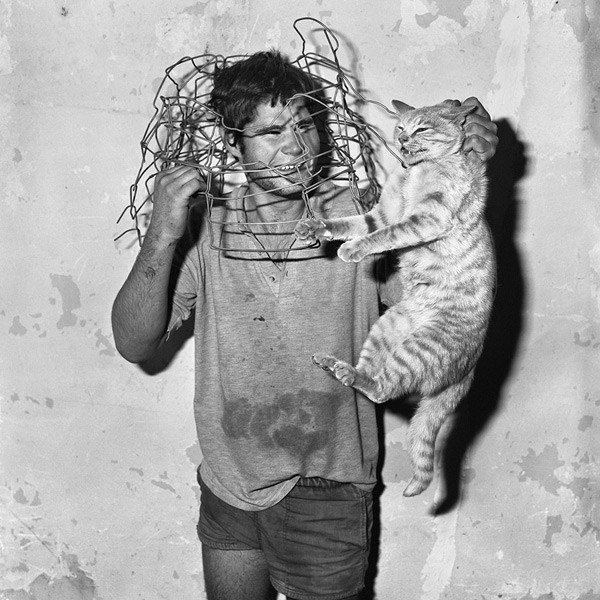 Cat Catcher, 1998
Cat Catcher, 1998
I met the Cat Catcher in 1996. He lived with his parents in a house in which cats and rats shared the same space. I would often see him walking along a road on the western side of Johannesburg, with a burlap bag and an intricate wire mask he had crafted himself. On one occasion I asked him what he was doing, and he responded by saying, “I am catching cats to sell to the sangoma [a traditional healer]. Can you take me to him, under the highway in Johannesburg?” As I had some time on my hands that afternoon, I agreed to his request and drove him to a metal shack near the highway.
There we were greeted by a man dressed in leopard skins – the sangoma. He grabbed the Cat Catcher’s sack, which was full of screeching cats, and weighed it. He then handed the Cat Catcher a bundle of notes for the nine kilograms of live cats he had caught. While all this was going on, I wandered into the backyard of the sangoma’s shack, where, to my surprise, I discovered cat skins, feet and ears hanging from various clothes lines. On the way back that day, the elated Cat Catcher asked me to photograph him with his mask and a cat he had just caught in an abandoned building.
You cannot beat life.
As an artist, you have maintained an admirable independence from the ‘recuperation’ to the status quo that tends to come with acclaim by the art world. How have you achieved this?
I was fortunate to have chosen a career in geology which allowed me to pursue my vision without being concerned about monetising my work. Consequently, I have never produced art for the purpose of pleasing an audience or second guessing their response. Since the late 1960s my goal in taking photographs has always been to better understand Roger. This process has been like writing my diary and the images that I leave behind will become like relics from the past.
In your most recent series, ‘Roger the Rat’, all the work features the eponymous rodent. Who is Roger the Rat, what makes him tick?
Roger the Rat represents the id of human consciousness. He acts out according to his inner state of mind and is not inhibited by social norms or values.
I will let Roger speak for himself…
“I am an outsider, live on the margin and have no place in human society. I am judged by humanity to be insane, to be feared and avoided at all costs. Normality must be preserved; it is sacrosanct, no matter what the cost… Most humans hate people such as me, as we challenge their illusion of stability and purpose. As a rat, I symbolise chaos and disorder. There is little hope of a better world until humanity comes to terms with the unpleasant fact that repression and fear are ultimately the masters of their destiny.”
“I cannot remember when I put this rat mask on for the first time. Maybe I was born with it. I am not sure what is underneath. I never take it off: I sleep with it, bathe with it. I have heard people call me a rat and others a human with a mask. I am unsure whether I am a rat or human. Perhaps my mother was a rat and my father a human. I think I am a bit of both.”
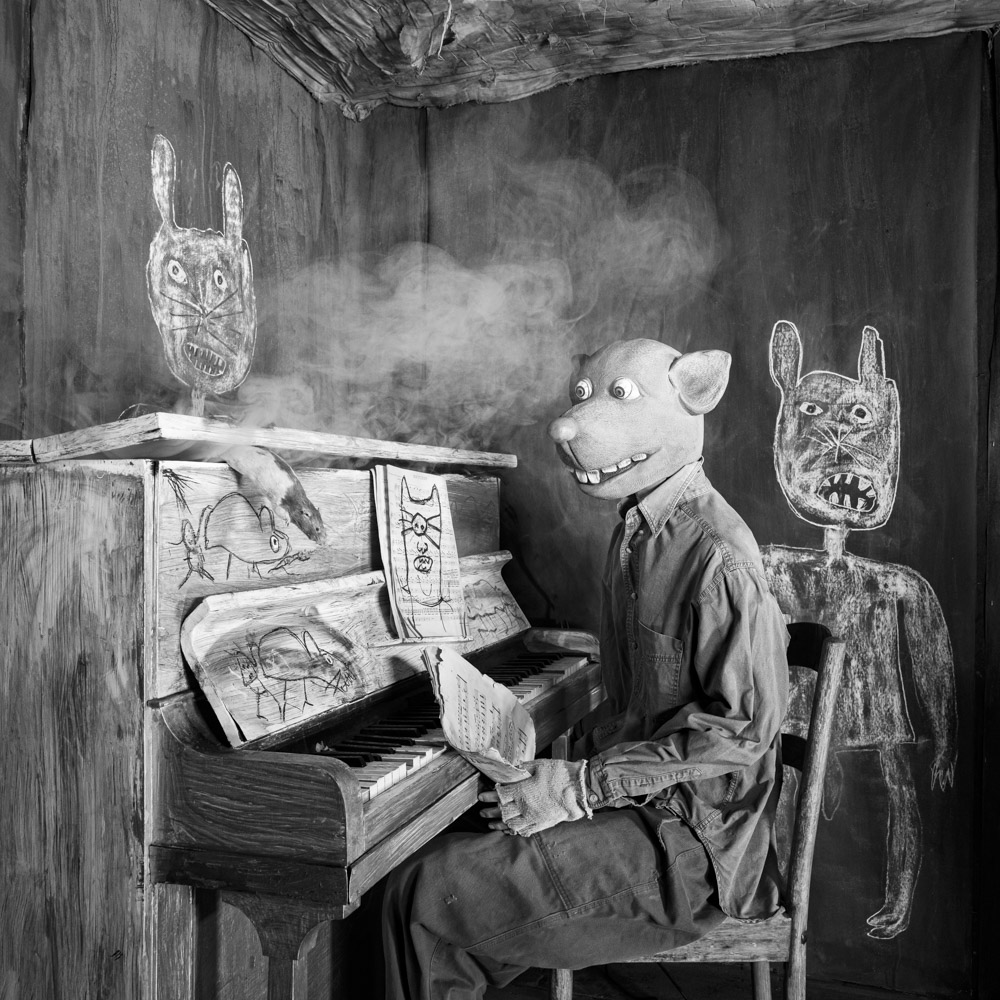 Smoked Out, 2020
Smoked Out, 2020
We now have the word ‘Ballenesque’ in our lexicon – I am not sure if that is an adjective, a noun, perhaps both? How would you write a concise dictionary definition?
Ballenesque is a viewpoint, expressed through the consciousness of Roger Ballen, in which animals, people, and props interact. It is a visual aesthetic related to the human condition that employs photography, video, installation, drawing and painting. The result is an archetypal vision characterised by absurdity, chaos, enigma, confusion, violence and contradiction that defies simplistic interpretation, and so can be best defined as Ballenesque.
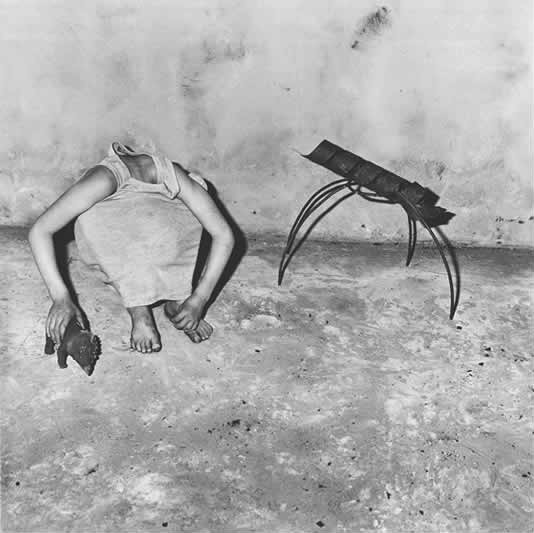 Head Inside Shirt, 2001
Head Inside Shirt, 2001

Comments are closed.